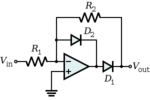alekvodnjan
Junior Member level 2
Hey, due to conversation with one guy something came to my mind. What if, after instrumentation amp, I put only RC filter (R goes to GND like on schematic few posts above) without op amp and bring coupled signal through 270 ohm resistor directly to ADC.
RC filter will bring AC signal from VGND to GND by clearing DC component. Clamp diodes on input to ADC will block -2.5 V and I'll have 0-2.5V AC signal to ADC. Then I can rise peak of signal amplitude with instrumentation amplifier to 5 V (now changes from 0-5 V). So due to that, I'll have better ADC 'cause now I can use all 1024 levels between 0-5 V and not only half as before. I'm only interested in max peak. So, I don't really need anything on the negative side.
I think this is the easiest way to test. With opamp I wanted to add DC component. Now with clamp diodes I don't have to. Or, eventually opamp does play some rule in this AC coupling even if I don't use it for adding DC component?
- - - Updated - - -
If you have some configurations with MC34063A please reffer me to some point where I can find them.
You are talking about capacitors at the output. Are you taking about Wien's capacitors or should I put some capacitors at the +-12V node like you did on TLE2426?
Also about 47R resistor at the output. Why is resistor before opamp feedback junction and not after if you know what I mean?
I'm trying to find some opamps you mentioned. Can you please name few. The local dealer's webshop page is very very bad. It gives only names of opamps and you can not filter it to get what you want. So I must search and examine every each of one and this is being frustrating... You don't have sub-categories like op amps, differential amps, PIC's and so on. Everything is under one category named IC's so I don't know what is what. Sometimes I open an comparator sometimes an opamp. Really terrible.
Due to problems with 78xx regulators you explained, I'll not use this method.
RC filter will bring AC signal from VGND to GND by clearing DC component. Clamp diodes on input to ADC will block -2.5 V and I'll have 0-2.5V AC signal to ADC. Then I can rise peak of signal amplitude with instrumentation amplifier to 5 V (now changes from 0-5 V). So due to that, I'll have better ADC 'cause now I can use all 1024 levels between 0-5 V and not only half as before. I'm only interested in max peak. So, I don't really need anything on the negative side.
I think this is the easiest way to test. With opamp I wanted to add DC component. Now with clamp diodes I don't have to. Or, eventually opamp does play some rule in this AC coupling even if I don't use it for adding DC component?
- - - Updated - - -
The MC34063A is a cheap and stable, it can be configured to give regulated step up or step down voltages and with either output polarity. You could use one for the +12V supply as well as it will dissipate less heat than a linear regulator.
If you have some configurations with MC34063A please reffer me to some point where I can find them.
The most precise mid-voltage will come from an op-amp splitter but you need one which can supply enough output current and at the same time be stable while driving a capacitive load. The resistor in series with the output pin in the schematic is to isolate it from the direct connection to capacitors on the + and - supply halves but as it appears in series with the virtual ground output it also limits the current you can pass through it. There are many high current 'buffer amplifiers' you can use, they are basically unity gain power amplifiers that are happy to drive capacitive loads, they do not need isolating resistors but they are considerably more expensive.
You are talking about capacitors at the output. Are you taking about Wien's capacitors or should I put some capacitors at the +-12V node like you did on TLE2426?
Also about 47R resistor at the output. Why is resistor before opamp feedback junction and not after if you know what I mean?
I'm trying to find some opamps you mentioned. Can you please name few. The local dealer's webshop page is very very bad. It gives only names of opamps and you can not filter it to get what you want. So I must search and examine every each of one and this is being frustrating... You don't have sub-categories like op amps, differential amps, PIC's and so on. Everything is under one category named IC's so I don't know what is what. Sometimes I open an comparator sometimes an opamp. Really terrible.
Due to problems with 78xx regulators you explained, I'll not use this method.

